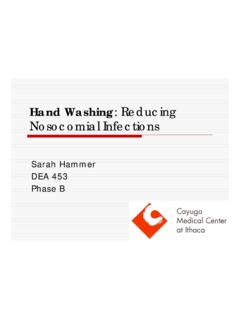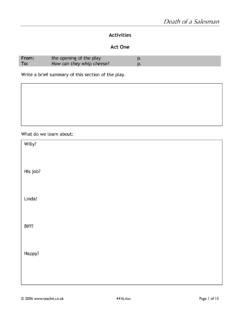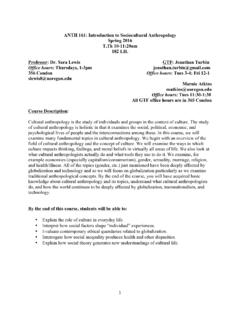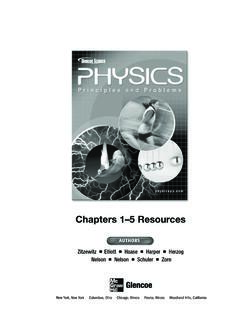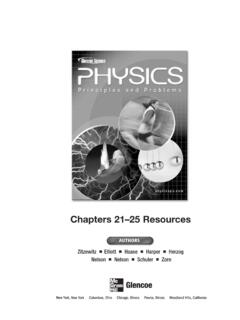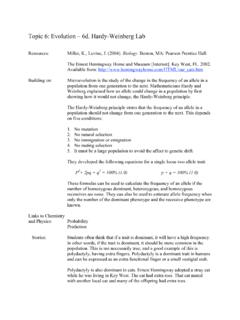Transcription of Evidence of Evolution2008 - WPMU DEV
1 Name _____ Period _____. Regents Biology Date _____. LAB ____. ANATOMICAL Evidence OF evolution . In our studies of the anatomy and development of animals we have discovered that many living creatures that look quite different on the surface have similarities underneath their skin that suggest that they are related to each other. This is Evidence that living creatures have evolved, or gradually changed over time. In this lab, you will learn about homologous, analogous, and vestigial structures and their value as Evidence for evolution . INSTRUCTIONS. A. HOMOLOGOUS STRUCTURES. There are many examples of body structures that are formed in similar ways during embryonic development and that share similar patterns of bone structure, even though they take on different forms and perform somewhat different functions.
2 These structures are called homologous structures. Homo- means same, and -logous means information, so homologous means same information . Homologous structures mean that the animals share a relatively recent common ancestor. 1. Carefully examine the drawings of forelimb skeletons shown in Figure 1 on the next page. Look for similarities in the bones amongst the various animals. 2. Color in the human arm first. Color the bones of the arm (the humerus, ulna, and radius). blue. Color the bones of the hand (the carpal, metacarpals, and phalanges) yellow. 3. Color the corresponding bones in each of the other animals the same color as the human bones.
3 4. Observe each of the skeletons again, and describe the function of each limb in the table below: Animal Function human Using tools, picking up and holding objects whale Used for swimming cat Used for running, pouncing, walking bat Used for flying bird Used for flying crocodile Used for walking 5. Answer the Summary Questions. 1 of 6. Developed by Kim B. Foglia 2008. Name _____ Regents Biology Figure 1. 2 of 6. Developed by Kim B. Foglia 2008. Name _____ Regents Biology B. ANALOGOUS STRUCTURES. There are also many examples of body structures in animals that are very similar in function and superficially similar in form and but develop very different and have very different internal structures and embryonic development.
4 These structures are called analogous structures. Analogous structures mean that the animals do not share a recent common ancestor. 1. Examine the butterfly wing and the bird wing shown in Figure 2. 2. Look for any similar bone structure. 3. Answer the Summary Questions. Figure 2. B. VESTIGIAL STRUCTURES. There are also many examples of body structures in animals that show gradual changes over time. In some cases, these changes have reduced or removed the function of some body parts and organs. These reduced or lost structures are called vestigial structures. The wings of penguins and the leg bones of snakes are examples of this phenomenon.
5 1. Observe the drawings of the cavefish and the minnow shown in Figure 3. The fish are related to each other but the cave fish is blind and only has the remnants of an eye. 2. Answer the Summary Questions. 3 of 6. Developed by Kim B. Foglia 2008. Name _____ Regents Biology SUMMARY QUESTIONS. HOMOLOGOUS STRUCTURES. 1. Are the functions of the limbs of each of the animals illustrated the same or different? BAT AND BIRD HAVE SAME FUNCTION, BUT ARE DIFFERENT FROM REST OF SPECIES. _____. 2. Are the bones of the limbs arranged in a similar or in a very different way in each animal? ARRANGED SIMILARLY.
6 _____. 3. Does the similarity in bone structure suggest a common ancestry amongst these animals? YES IT SUGGESTS A COMMON ANCESTRY. _____. 4. Offer a possible evolutionary explanation for how the skeletons can be similar but the functions very different in each of the animals. THE SPECIES ILLUSTRATED HAVE SIMILAR BONE STRUCTURES SUGGESTING. _____. COMMON ANCESTRY. HOWEVER THOSE STRUCTURES HAVE DIFFERENT FUNCTIONS. _____. DEPENDING ON EACH SPECIES' ENVIRONMENT. _____. ANALOGOUS STRUCTURES. 5. What function do the butterfly and bird wings share? THEY SHARE THE SAME FUNCTION. _____. 6. In what way do these structures differ?
7 ALTHOUGH THEY HAVE THE SAME FUNCTION THEY HAVE A DIFFERENT. _____. ANCESTOR. (THEY DON'T SHARE SAME ANATOMICAL STRUCTURES). _____. _____. 7. Explain why these are considered analogous structures and not homologous structures. WINGS OF BATS AND BUTTERFLIES ARE ANALOGOUS BECAUSE. _____. THEY SERVE THE SAME FUNCTION BUT NO COMMON ANCESTRY. _____. 4 of 6. Developed by Kim B. Foglia 2008. Name _____ Regents Biology VESTIGIAL STRUCTURES. 8. Explain why eyesight is not an important adaptation to life in a deep sea cave. DEEP SEA CAVES ARE DARK SO EYESIGHT IS NOT AN ADAPTATION. _____. LIVING THINGS THERE USE TO SURVIVE.
8 EYESIGHT NEEDS LIGHT. _____. 9. Does the appearance of the cavefish and the minnow suggest a common ancestry? Why? YES. THEY HAVE STREAMLINED BODIES WITH THE SAME FIN. _____. ARRANGEMENT AND EYE/MOUTH POSITIONING. _____. _____. 10. Below is a list of human vestigial structures. Suggest a possible function for each structure and explain why it is considered vestigial. Structure Probable Function Why Vestigial? To provide hormones or We don't have the same appendix digestive enzymes for the use for the appendix food available at the time anymore. Indicates presence of a tail, We don't have to hang coccyx (tail bone) needed for holding on to from trees anymore limbs, balance :).
9 Allowing animal to focus muscle that move hearing on predators or prey We don't have natural ears for survival predators we have alternate ways of muscles that make sign of aggression, cooling hair stand up defense. Not enough hair for cooling properties. Extra support for walking we walk on plain terrain little toe or have shoes for balance wisdom teeth Crushing bones and tree Our food is tenderized limbs. 5 of 6. Developed by Kim B. Foglia 2008. Name _____ Regents Biology OVERVIEW QUESTIONS. 11. Explain how homologous structures are Evidence of a common ancestor. HOMOLOGOUS STRUCTURES SHOW COMMON ANCESTRY.
10 SIMILARITIES. _____. IN BONE ARRANGEMENT, AND STRUCTURE ARE INDICATORS. _____. OF COMMON ANCESTRY. _____. _____. 12. Explain the evolutionary relationship between the fin of a fish and the flipper of whale. FISH AND WHALE FINS ARE ANALOGOUS, SIMILAR IN FUNCTION. _____. BUT WITHOUT SIMILAR STRUCTURES THAT WOULD REVEAL. _____. COMMON ANCESTRY. _____. 13. List another structure (not listed in this lab) that you think is vestigial and explain why. MALE NIPPLES. BECAUSE LATER IN DEVELOPMENTAL STAGES. _____. MEN PRODUCE TESTOSTERONES, BREAST DEVELOPMENT ALSO. _____. HALTS. _____. 6 of 6. Developed by Kim B.


